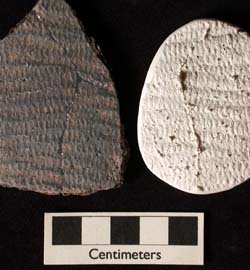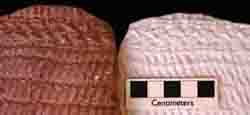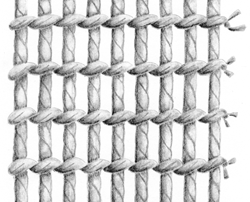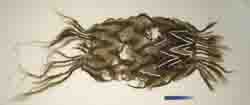An Introduction to the Anthropology of Textiles in Southeastern North America
The research and consultation offered by Mary Spanos focuses on the prehistoric and early historic textiles of the Southeastern region of North America. Her research begins with the earliest Native American occupants and continues through the settlement of the Europeans. The textile life of this geographic region over this time period offers a complex and fascinating story that is unique among prehistoric cultures and had a dramatic affect on world economies during the early historic period. The basic milestones are presented below.
-
Eight thousand years ago, Paleoindians left
impressions of woven materials (possibly basketry or matting) in clay floor surfaces in
Dust Cave in north Alabama (Sherwood 2001:99).
- Two-thousand years ago, Woodland Indians used handspun yarn and handmade fabric to decorate pottery in the Tennessee River Basin (Dunlevy 1948:55; Knight 1990; Spanos 2006).
- Five hundred years ago, Mississippian Indians left behind textile artifacts that included garments, bags, footwear, fabric-impressed pottery, and images of textiles on copper ceremonial objects (Drooker 1992:58-94; Kuttruff and Kuttruff 1996:161-172; Schreffler 1988:124-130).
- Europeans came to North America looking for many things, including relief from the resource constraint of limited arable land back home. One limitation in particular that was affected by a limitation of farm land, was the need to pay high import costs for what was then a popular luxury item, cotton.
- Eli Whitney received the first patent awarded by the newly formed United States and became an important advertisement for the ingenuity and hope of the new nation. However, the facts indicate a different story. History shows that a variety of cotton gins, tools for separating the seeds from the cotton fibers, had long been in use around the world (Lakwete 2003).
- By 1838, cotton accounted for 87.5% of the total U.S. exports (Farnie and Jeremy 2004).
- The industrial revolution included many innovations in textile production that freed people from the need to raise their own fiber producing plants and animals, prepare their own fibers for spinning, spin their own yarn, make their own cloth, and sew their own clothing. Central to that development, but often over-looked, are the mechanized spinning machines, and the sewing machine. Until the early 19th century, much of the clothing in the world was made by hand: hand-raised fiber plants and animals, hand-processed fibers for spinning, hand-spun yarn, hand-woven cloth, and hand-sewn (needle and thread, not by machine) garments. The labor investment and the coordination among the manufacturing groups constituted a large portion of every Western culture.
- In the 1830s just prior to their removal from the Southeast, Indians were wearing traditional handmade textile accessories with their newly traded European clothing and were assembling cotton cloth factories to gin, spin, and weave the cotton they were raising (Wickman 1991:135-136; Carson 1999:79).
The textile story of the Southeastern region of North America began with the Native Americans. The Europeans who came to this area brought their social standards and their technology with them. From the moment the two cultures met, they affected each other, for better and for worse, and their textiles and their cultures reflect the accultration of every group involved.
Referenes Cited
Carson, James T.1999 Searching for the Bright Path: The Mississippi Choctaws from Prehistory to Removal. University of Nebraska Press, Lincoln.
Drooker, Penelope B.
1992 Mississippian Village Textiles at Wickliffe. University of Alabama Press, Tuscaloosa.
Dunlevy, Marion L.
1948 Pottery Study. In Little Bear Creek Site CTo8, Colbert County Alabama, by William S. Webb and David L. DeJarnette, pp. 55-64. Alabama Museum of Natural History, University.
Farnie, Douglas A., and David J. Jeremy
2004 The Role of Cotton as a World Power, 1780-1990. In The Fibre That Changed the World: The Cotton Industry in International Perspective, 1600-1990s, edited by Douglas A. Farnie and David J. Jeremy, pp. 3-14. Pasold Research Fund, Oxford University Press, Oxford.
Knight, Vernon J., Jr.
1990 Excavation of the Truncated Mound at the Walling Site: Middle Woodland Culture and Copena in the Tennessee Valley. Alabama State Museum of Natural History, Division of Archaeology, Report of Investigations 56. University of Alabama.
Kuttruff, Jenna T., and Carl Kuttruff
1996 Mississippian Textile Evidence on Fabric-Impressed Ceramics from Mound Bottom, Tennessee. In A Most Indispensable Art: Native Fiber Industries from Eastern North America, edited by James B. Petersen, pp. 160-173. University of Tennessee Press, Knoxville.
Lakwete, Angela
2003 Inventing the Cotton Gin: Machine and Myth in Antebellum America. Johns Hopkins University Press, Baltimore.
Schreffler, Virginia L.
1988 Burial Status Differentiation as Evidenced by Fabrics from Etowah Mound C. Georgia. Ph.D. dissertation, Department of Textiles and Clothing, Ohio State University, Columbus. University Microfilms, Ann Arbor.
Sherwood, Sarah C.
2001 The Geoarchaeology of Dust Cave: A Late Paleoindian Through Middle Archaic Site in the Western Middle Tennessee River Valley. Ph.D. dissertation, University of Tennessee, Knoxville.
Spanos, Mary
2006 Mississippian Textiles at Beckum Village (1Ck24), Clarke County, Alabama. M.A. thesis, University of Alabama, Tuscaloosa.
Wickman, Patricia R.
1991 Osceola’s Legacy. University of Alabama Press, Tuscaloosa.



